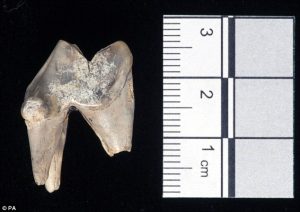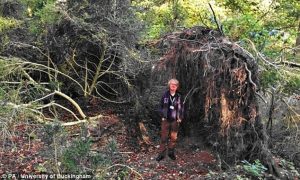
- A tooth belonging to a dog dating back 7,500 years has been discovered
- It was found in the grounds of a nursing home just a mile from Stonehenge
- Researchers say it points to the early connections between man and dog
Taking the dog for a walk seems like a tradition as old as time itself.
But now we are one step closer to finding out exactly when the special connection between a man and his dog began.
Archaeologists have found evidence of the oldest known ‘walkies’. And not only was it roughly 7,500 years ago, but it was also an epic 250 miles.
A tooth belonging to a domesticated dog thought to resemble an Alsatian has been found in the grounds of a nursing home a mile from Stonehenge.
Analysis reveals that the dog was originally from the Vale of York.
For the tooth to be found at Blick Mead, Wiltshire, means it must have accompanied humans to the site during the Mesolithic era.
This was 2,000 years before the big stone monuments were erected at Stonehenge. Bones also found at the site – gnawed by dogs – include those of an auroch, a type of huge, aggressive cow.
Other bones found nearby show the dog would have feasted on salmon, trout, pike, wild pig and red deer.
David Jacques, a senior research fellow at the University of Buckingham, said the findings were significant because archaeologists did not know people travelled such long distances.
He said it also adds to the weight of evidence that people came to meet in the Stonehenge area millennia before the monument was built.
Previous excavations at the site uncovered a slate tool from Wales and stone tools from the Midlands and West of England.
As the Ice Age had just ended, one of the attractions of Blick Mead would have been a natural spring in which the only puce stones in the country could be found.
It would also have been relatively easy to reach because of the nearby River Avon, which was a major transport route at the time.
Burnt stones, wood and auroch bones from the site indicate that it was popular for feasting, an important ritual activity.
Mr Jacques said: ‘The fact that a dog and a group of people were coming to the area from such a long distance away further underlines just how important the place was four millennia before the circle was built.

Archaeologist David Jacques from the University of Buckingham (pictured) claims to have found evidence that Mesolithic man’s best friend was an Alsatian
‘Discoveries like this give us a completely new understanding of the establishment of the ritual landscape and make Stonehenge even more special than we thought we knew it was.’
He added that the population of Britain at the time is thought to have been 20-50,000.
He said: ‘These were small, disparate populations that needed to come together to exchange ideas and technologies.
‘For these people, meeting would have been like Glastonbury mixed with Google.’
Andy Rhind-Tutt, chairman of Amesbury Museum and Heritage Trust, said: ‘These amazing discoveries at Blick Mead are writing the history books of Mesolithic Britain.
‘A dog tooth from York, a slate tool from Wales and a stone tool from the Midlands show that this wasn’t just the place to live at the end of the Ice Age, but was known by our ancestors for a long time widely across Britain. They kept coming here.’
Previous finds at the site have shown that Mesolithic man used to feast on toads’ legs.
At the time of the discovery in 2013, Mr Jacques said: ‘It would appear that thousands of years ago people were eating a Heston Blumenthal-style menu on this site.
‘It consisted of toads’ legs, aurochs, wild boar and red deer with hazelnuts for main, a course of salmon and trout and finishing off with blackberries.’










